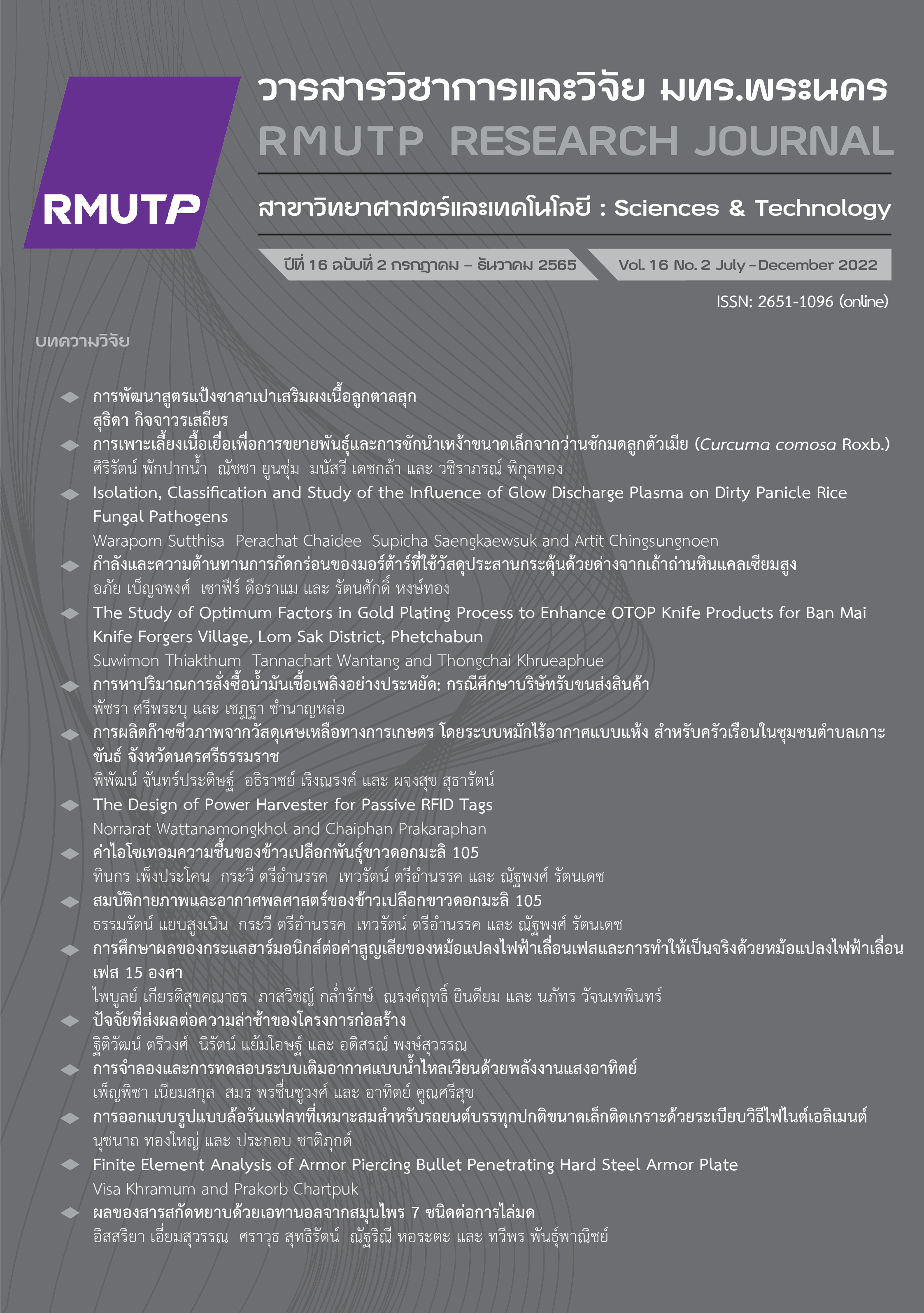The Study of Optimum Factors in Gold Plating Process to Enhance OTOP Knife Products for Ban Mai Knife Forgers Village, Lom Sak District, Phetchabun
Main Article Content
Abstract
This research aimed to study the optimum factors affecting the quality of gold plating process to enhance OTOP knife products of Ban Mai knife forgers village. This study focused on application of AISI 5160 steel and the 24k gold plating process.In the experiment, three samples of plating currents were observed; 10, 12, and 14 volts, each at 30, 60, 90, 120, 150 seconds, and 180 seconds, respectively. The study found that applying the electric currents in gold plating at 12 volts for 120 seconds gave the best results for the gold color and thickness, by giving the thickness of the gold surface at 33.82 micron and the color value between L*=88.72, a*=4.45 and b*=78.58. Moreover, the gold dispersion was consistent throughout the workpiece. From applying the electric currents in gold plating at 10 volts, it lessened the thickness of the gold plating which made the gold plating look uneven. From applying the electric currents in gold plating at 14 volts, it increased the thickness of the gold plating which resulted in a dull or burned finish from over-plating. In comparison, the cost of the knife before plating with gold costs only 30 baht per piece while the cost of the knife after plating with gold costs 99 baht per piece. In conclusion, the daily sales of a product increase from 50-60 items per day to 60-75 items per day, which also resulted in increased revenue and profitability from 1,500-1,800 baht per day to 5,940-7,425 baht per day on average.
Article Details

This work is licensed under a Creative Commons Attribution-NonCommercial-NoDerivatives 4.0 International License.
ลิขสิทธ์ ของมหาวิทยาลัยเทคโนโลยีราชมงคลพระนครReferences
S. Srisawad, T. Khrueaphue and S. Theakthum, “Design and Fabrication of Tobacco Leaf-stripping Machine to Enhance Economic Production of Farmers in Phetchabun Province,” SNRU Jour nal of Science and Technology, vol. 12, no. 3, pp. 198-206, 2016.
N. Prayalaw and L. Manmart, “Factors affecting consumers’ purchasing decision in food product of one Tambon one Product project produced in Khon Kaen province,” KKU Research Journal (Graduate Studies) Humanities and Social Sciences, vol. 3, no. 1, pp. 38-51, 2015.
S. Theakthum and T. Wantang, “Value Added OTOP Products of Tamarind Metal Souvenir Keychains with Anodizing,” in Proceeding of 55th Kasetsart University Annual Conference, Bangkok: Kasetsart University, 2017.
P. Inkong, “Development of the northern souvenir product in promoting creative economic tourism: A case study of Yao tribal group,” Journal of fine arts research and applied arts, vol. 1, no. 2, pp. 21-41, 2014.
U. Inprasit, “Tourist Satisfaction of the Development of Antique Silver Jewelry Styles,” Si Satchanalai District, Sukhothai. Parichart Journal, vol. 31, no. 3, pp. 225-236, 2018.
P. Pitsuwan, P. Suwan, Y. Sengty and P. Kongsong, “Influence of Catalyst on Surface Hardening of Low Carbon Steel by Pack Carburizing with Mangrove Charcoal Powder,” Journal of Industrial Technology Ubon Ratchathani Rajabhat University, vol. 8, no. 2, pp. 1-12, 2017.
O. Tetsuya, O. Yutaka, S. Junji and K. Masaru, “Development of new electrolytic and electroless gold plating processes for electronics applications,” Science and Technology of Advanced Materials, vol. 7, no. 5, pp. 425–437, 2006.
V. Vaghela, N.K. Shah and V.V. Limaye, “Optimization of various parameters in gold electrodeposition for microelectronics,” International Journal of Technical Research and Applications, vol. 5, no. 3, pp. 129-131, 2017.
G.K. Mishra and K.G. Paramguru, “Surface modification with copper by electroless deposition technique: An overview,” Pure and Applied Chemistry, vol. 4, no. 6, pp. 87-99, 2010.
F. Hanna, Z.A. Hamid and A.A. Aal, “Controlling Factors Affecting the Stability and Rate of Electroless Copper Plating,” Materials Letters, vol. 58, no. 1–2, pp. 104-109, 2003.
M. Sun, P. Michael, A. Marjorie and E. Natishan, “A comparative assessment of gold plating thickness required for stationary electrical contacts,” Microelectronics Journal, vol. 30, no. 1999, pp. 217-222, 2000.
S. Malanusorn, “Determination of gold selective plating thickness effecting factor for high speed plating productivity improvement,” Master of engineering thesis Faculty of engineering, Thammasat University, Thailand, 2004.


